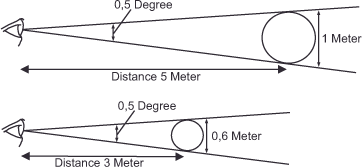You are here: Nature Science Photography – Image creation, Depth and Size – Size perception
According to everything we know from the chapter on physiological image creation, our perception of the size of an object must at least depend on how much space its image occupies on the retina. This retinal image is determined by the actual object size and distance from which the visual angle is derived.
The angle at which we perceive an object is known as the angle of view.
If we think it through to the end, this relationship means that two objects of the same size at different distances from the observer can have different viewing angles (and retinal images of different sizes), but two objects of different sizes at the right distance can also have the same viewing angle (and retinal images of the same size). We can verify this truth during every solar eclipse. On this occasion, the small moon (3,476 km in diameter and on average 384,405 km away from the earth) almost completely covers the huge sun (1.392 million km in diameter and on average 146 million km away from the earth), because both have the same visual angle for us. Furthermore, our perception of an object’s size would have to change depending on our distance from it. Surprisingly, this is not true, as you surely know from everyday experience and can easily reproduce in a small experiment. Take a sheet of paper and fix it to a wall or, if you have a longer hallway, to the door of your apartment. Then look at the sheet once, from a distance of one meter, and once, from a distance of five meters. Due to the changed viewing distance, you perceive the object at significantly different viewing angles, but it still appears approximately the same size in both cases.
The retinal image oriented to the angle of vision thus gives us information about the relative sizes of the objects among each other, but to infer the approximate true size of things, we have to consider more than that. And indeed, for this purpose, we also consult depth and distance perception, as we can demonstrate in various experiments.

Next Building blocks of our size perception – The settlement of distance
Main Image creation, Depth and Size
Previous Control and correction of the central perspective


 Since I started my first website in the year 2000, I’ve written and published ten books in the German language about photographing the amazing natural wonders of the American West, the details of our visual perception and its photography-related counterparts, and tried to shed some light on the immaterial concepts of quantum and chaos. Now all this material becomes freely accessible on this dedicated English website. I hope many of you find answers and inspiration there. My books are on
Since I started my first website in the year 2000, I’ve written and published ten books in the German language about photographing the amazing natural wonders of the American West, the details of our visual perception and its photography-related counterparts, and tried to shed some light on the immaterial concepts of quantum and chaos. Now all this material becomes freely accessible on this dedicated English website. I hope many of you find answers and inspiration there. My books are on